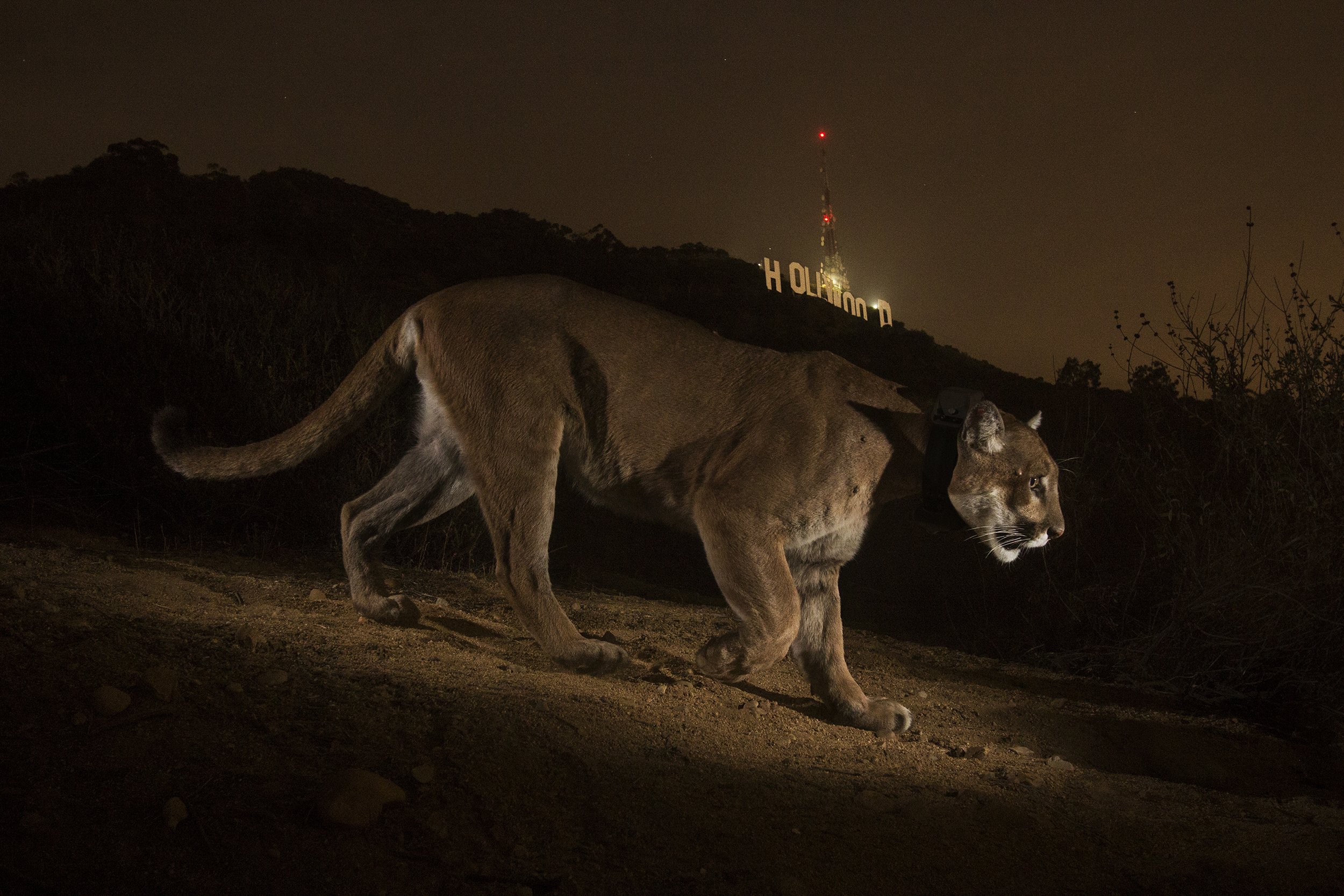
P-22: The mountain lion of Los Angeles
Lesson learned from P22 for urban wildlife and how we can coexist
The Celebration for Life for P22 brought Angelenos together to remember and celebrate the mountain lion that taught us that we can, and should, coexist with the natural world that surrounds us. P22 inspired the project that has become the Wallis Annenberg Wildlife Crossing, a reminder that we have to not only live peacefully with, but protect the natural world from our noisiest and most dangerous incursions. During the program, representatives of the National Park Service shared what P22 taught us about urban wildlife.
NPS has been studying wildlife in the Santa Monica Mountains for decades. The first collared mountain lion, P1, was collared in 2002. Santa Monica Mountains Fund plays a critical role in fundraising for wildlife research and building awareness around wildlife coexistence. National Park Service Biologists Jeff Sikich, Seth Riley, and Park Superintendent David Szymanski spoke about lessons learned from P22, as well as how humans can live respecting wildlife in our urban areas.
"P22 had a long life at Griffith Park because you allowed it. Instead of seeing pumas as animals to be feared, hunted and exterminated, you welcomed him," said Superintendent David Szymanski for the Santa Monica Mountains National Recreation Area. NPS Wildlife Branch Chief, Seth Riley added "P22 taught us some critical lessons. He taught us what wildlife has to go through to survive in the second-largest city in the country...... But, he also showed us what wildlife is capable of...... He also left us an amazing legacy. He increased awareness and concern for wildlife connectivity."
NPS Biologist Jeff Sikich, who captured P22 seven times to replace radio collars and check his health, spoke of his adventures with P22. "I've studied hundreds of large carnivores in my career and never could I have imagined that one of these animals could bring so many people together in celebration of coexistence," said Sikich. Sikich also emphasized the mountain lion's role as an ambassador for understanding urban wildlife and spoke about how P22 suffered like all urban wildlife with rodenticide poisoning, poor habitat connectivity, and busy roads. Sikich, who may have known P22 better than anyone reminded us: "His legacy will live on."
Learn more about SAMO Fund’s work for wildlife
Help us combat rodenticides
Learn to live with wildlife
Support wildlife research for the National Park Service, at: www.samofund.org/donate

SAMO Fund supports NPS studies of urban animals, including mountain lions, as well as coyotes, bobcats, deer and other animals.
Statement on P-22 from Santa Monica Mountains National Recreation Area
The National Park Service joins our partners, friends, and community members here in Los Angeles, and around the world, in remembering mountain lion P-22.
Learn more in California Department of Fish and Wildlife's news release: Mountain Lion P-22 Compassionately Euthanized Following Complete Health Evaluation Results
Mountain lion P-22 was more than just a celebrity cat. He was also a critical part of a long-term research study and a valuable ambassador for the cause of connectivity and for wildlife in the Santa Monica Mountains and beyond.
He was one of the oldest mountain lions in a study that the National Park Service has been conducting since 2002 and one of its most interesting. When he was captured and collared in March 2012 by National Park Service biologists, he was estimated to be about 2 years old.
Likely born in the Santa Monica Mountains as the son of adult male P-1, he somehow found his way to his tiny, nine-square-mile home in Griffith Park, separated from the Santa Monicas by the 101 and 405, two of the busiest freeways in the world. Defying expectations, he persisted for more than 10 years in the smallest home range that has ever been recorded for an adult male mountain lion.
Although he made frequent appearances on the streets of the Hollywood Hills and even, more recently, of the Silver Lake neighborhood, he was also clearly a wild cat, doing so mostly late at night, and subsisting largely on natural prey such as deer and coyotes.
In the end, he found his way into many Angelenos' hearts and home surveillance camera footage.
Park biologists aim to understand and conserve the species that live in and around the park for generations to come. Although P-22 is now physically gone, scientists will be analyzing his data for years to come.
This animal's life and safe passage to Griffith Park are a testament to both the challenges and the possibilities for wildlife in Los Angeles. He showed us what mountain lions must do to survive in our urban landscape, as he dispersed through it to find a remaining island of habitat.
He also showed us what they are capable of: surviving and co-existing with millions of people in a city as dense and sprawling as Los Angeles.
Goodbye, P-22. Your scientific legacy will live on.
NPS has been studying mountain lions in and around the Santa Monica Mountains for the last two decades to determine how they survive in a fragmented and urbanized environment. CDFW is responsible for overseeing the management and conservation of mountain lions in the state.
SAMO Fund supports the two-decades-long NPS study of our mountain lions by purchasing radio collars, tracking vehicles, anticoagulant testing, health diagnostics and disease surveys. SAMO Fund also provides satellite collars and necropsy tests to determine the major threats to the local bobcat population.









